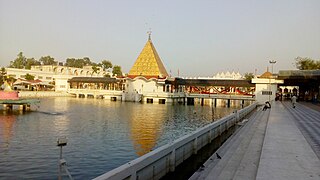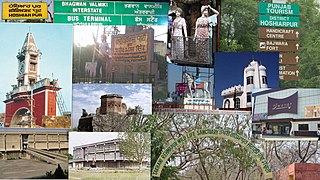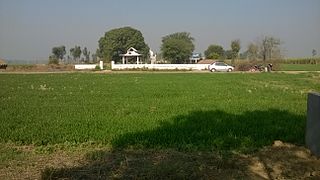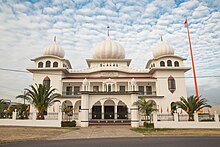
Punjab is a geopolitical, cultural, and historical region in South Asia. It is specifically located in the northwestern part of the Indian subcontinent, comprising areas of modern-day eastern-Pakistan and northwestern-India. Punjab's major cities are Lahore, Faisalabad, Rawalpindi, Gujranwala, Multan, Ludhiana, Amritsar, Sialkot, Chandigarh, Shimla, Jalandhar, Patiala, Gurugram, and Bahawalpur.

Jalandhar is a city in the state of Punjab in India. With a considerable population, it ranks as the third most-populous city in the state and is the largest city in the Doaba region. Jalandhar lies alongside the historical Grand Trunk Road and is a well-connected junction for both rail and road networks.

Gurdaspur district is a district in the Majha region of the state of Punjab, India. Gurdaspur is the district headquarters. It internationally borders Narowal District of Pakistani Punjab, and the districts of Amritsar, Pathankot, Kapurthala and Hoshiarpur. Two main rivers Beas and Ravi passes through the district. The Mughal emperor Akbar is said to have been enthroned in a garden near Kalanaur, a historically important town in the district. The district is at the foothills of the Himalayas.

Hoshiarpur is a city and a municipal corporation in Hoshiarpur district in the Doaba region of the Indian state of Punjab. It was founded, according to tradition, during the early part of the fourteenth century. In 1809, it was occupied by the forces of Maharaja Karanvir Singh and was united into the greater state of Punjab in 1849.

Hoshiarpur district is a district of Punjab state in northern India. Hoshiarpur, one of the oldest districts of Punjab, is located in the North-east part of the Punjab state and shares common boundaries with Gurdaspur district in the north-west, Jalandhar district and Kapurthala district in south-west, Kangra district and Una district of Himachal Pradesh in the north-east. Hoshiarpur district comprises 4 sub-divisions, 10 community development blocks, 9 urban local bodies and 1417 villages. The district has an area of 3365 km2. and a population of 1,586,625 persons as per census 2011.

Jalandhar district is a district in Doaba region of the state of Punjab, India. The district headquarters is the city of Jalandhar.

Shaheed Bhagat Singh Nagar district is one of twenty-three districts of state of Punjab, India. It is located in Doaba region. It consists of three subdivisions, Nawanshahr, Banga, and Balachaur. There are three legislative seats in the district, Nawanshahr, Balachaur and Banga. They fall under the Anandpur Sahib Lok Sabha Constituency. Nawanshahr, the district headquarters is about 92 kilometres (57 mi) from Chandigarh, the state's capital.

Doaba, also known as Bist Doab or the Jalandhar Doab, is the region of Punjab, India that lies between the Beas River and the Sutlej River. People of this region are given the demonym "Doabia". The dialect of Punjabi spoken in Doaba is called "Doabi". The term "Doaba" or "Doab" is derived from Persian دو آب meaning "land of two rivers". The river Sutlej separates Doaba from the Malwa region to its south and the river Beas separates Doaba from the Majha region to its north.

Woolgoolga is a town on the Mid North Coast of New South Wales, Australia. It is on the Pacific Highway, approximately 550 km north of Sydney and 365 km south of Brisbane. The closest city to Woolgoolga is Coffs Harbour, which lies 24.8 km to the south. Woolgoolga has two beaches on the Pacific Ocean. The area has long been a centre of banana growing in New South Wales, but this industry has declined in the face of competition from Queensland. Recent times have seen many banana plantations replaced by blueberries after banana sales slumped in the late 1990s.
Naura is a town in the Shahid Bhagat Singh Nagar district of Punjab, India. It is located about 2 km from Khatkar Kalan, the home town of Shaheed Bhagat Singh, on the Banga - Gharshanker road. Jawaharlal Nehru, first Prime Minister of India visited Naura attending agricultural trade show along with his daughter Indira Gandhi. The town is nicknamed across many Punjabi villages as: "Naura Bhaura".
Padhiana is a village in the tehsil and district of Jalandhar, Punjab, India. It falls in Adampur block of the district. The village has 794 hectares of land. The population of Padhiana was 2885 at the 1991 census.
Khatkar Kalan is a village just outside Banga town in Shaheed Bhagat Singh Nagar district in the Indian state of Punjab. This place is famous for the memorial of Bhagat Singh, an Indian freedom fighter, who was born in Banga, present day village in Pakistan in 1907 and after whom the district is also named. Khurd and Kalan mean small and large respectively, when two villages have the same name they are distinguished by using Kalan or Khurd with the village name.

Punjab, historically known as Panchanada (Sanskrit) or Pentapotamia, is a state in northern India. Forming part of the larger Punjab region of the Indian subcontinent, the state is bordered by the Indian states of Himachal Pradesh to the north and northeast, Haryana to the south and southeast, and Rajasthan to the southwest; by the Indian union territories of Chandigarh to the east and Jammu and Kashmir to the north. It shares an international border with Punjab, a province of Pakistan to the west. The state covers an area of 50,362 square kilometres, which is 1.53% of India's total geographical area, making it the 19th-largest Indian state by area out of 28 Indian states. With over 27 million inhabitants, Punjab is the 16th-largest Indian state by population, comprising 23 districts. Punjabi, written in the Gurmukhi script, is the most widely spoken and the official language of the state. The main ethnic group are the Punjabis, with Sikhs (57.7%) and Hindus (38.5%) forming the dominant religious groups. The state capital, Chandigarh, is a union territory and also the capital of the neighbouring state of Haryana. Three tributaries of the Indus River — the Sutlej, Beas, and Ravi — flow through Punjab.
Jajja Khurd is a village (Pind) 2 km from the market town of Apra and within close proximity of Phagwara, Phillaur, Goraya and Banga. Kalan is Persian language word which means Big and Khurd is Persian word which means small when two villages have same name then it is distinguished with Kalan means Big and Khurd means Small used with Village Name. It is within the Doaba region of Punjab in India in the Jalandhar district, close to the boundary of Nawanshahr district. There is a majority of Garcha/Sandhu surnames residing in the village.
Gobindpur is a village in Shaheed Bhagat Singh Nagar district of in the Indian state of Punjab. it was originally known as Salaimpur, but later had its name changed to Gobindpur after Guru Hargobind visited it in the 17th century. It is located 3.8 kilometres (2.4 mi) away from City Banga, 19.7 kilometres (12.2 mi) from district headquarters Nawanshahr and 110 kilometres (68 mi) from state capital Chandigarh. The village is administrated by Sarpanch an elected representative of the village.

British Punjabis are citizens or residents of the United Kingdom whose heritage originates wholly or partly in the Punjab, a region in the Indian subcontinent, which is divided between India and Pakistan. Numbering 700,000 in 2006, Punjabis represent the largest ethnicity among British Asians. They are a major sub-group of the British-Indian and British Pakistani communities.
Jindowal is a village in Shaheed Bhagat Singh Nagar district of Punjab State, India. It is located 1.6 kilometres (0.99 mi) away postal head office Banga, 15 kilometres (9.3 mi) from Garhshankar, 12 kilometres (7.5 mi) from district headquarter Shaheed Bhagat Singh Nagar and 103 kilometres (64 mi) from state capital Chandigarh. The village is administrated by Sarpanch an elected representative of the village.
Bhangal Kalan is a village in Shaheed Bhagat Singh Nagar district of Punjab State, India. Kalan is a Persian word for big and Khurd is a Persian word for small, when two villages have the same name they are distinguished by using Kalan or Khurd with the village name. It is situated on Bahara-Nawanshahr link road and located 6.7 kilometres (4.2 mi) away from postal head office Sahlon, 10 kilometres (6.2 mi) from Rahon, 3.3 kilometres (2.1 mi) from district headquarter Shaheed Bhagat Singh Nagar and 94 kilometres (58 mi) from state capital Chandigarh. The village is administrated by Sarpanch an elected representative of the village.
Jhander Kalan is a village in Shaheed Bhagat Singh Nagar district of Punjab State, India. Kalan is a Persian word for big and Khurd is a Persian word for small, when two villages have the same name they are distinguished by using Kalan or Khurd with the village name. It is located 9.2 kilometres (5.7 mi) away from postal head office Banga, 23 kilometres (14 mi) from Phagwara, 20 kilometres (12 mi) from district headquarter Shaheed Bhagat Singh Nagar and 113 kilometres (70 mi) from state capital Chandigarh. The village is administrated by Sarpanch an elected representative of the village.
Punjabi Australians are Australians who are of Punjabi descent. According to the 2016 census, Punjabi is one of the fastest-growing languages in Australia, with 132,499 individuals identifying as Punjabi-speakers. This is an increase from 71,230 individuals in 2011 and 26,000 individuals in 2006, representing a five-fold growth in 10 years.



















